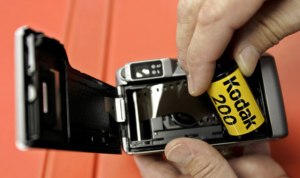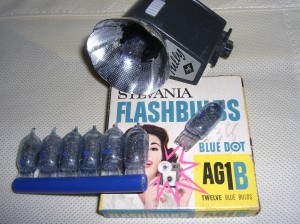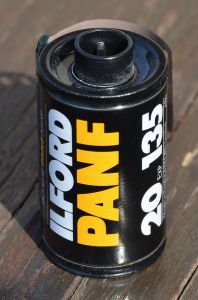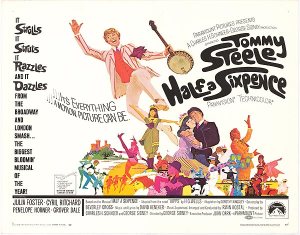[241] Flash, Bang, Wallop!
Issued April 2015. Revised and updated November 2019.
I’ve done it again. I was half way through doing a blog about Chemists and I had to say something about photography. It just grew and grew into a separate post. This is all about photography. Chemists will come later!
Nowadays, we are getting to the stage where mobile phones and tablet computers have taken over digital photography and cameras have almost disappeared in general use. To go back to the Fifties and Sixties, we need to forget these modern developments and forget all about digital photography. Things then were much more crude.
I have said something about early photography, at the seaside, before it was generally available to the public, in [225] ‘I know a Dark, Secluded Place.’ We come now to our first steps into photography in our family (and many other families at that time).
Kodak Brownie
At some time in the early Fifties, my father bought a box Brownie camera – a simple bakelite camera widely used in the Fifties and Sixties. It could take eight pictures (photographs, not photos) by using a light sensitive film strip. [217] ‘Feared by the BBC, Loved by the ITV’ said something about the process of making films. Still photography had some similarities.
Loading the camera
The picture above is a much more modern camera but is shows something of how they were loaded. The film, coiled in its container is light sensitive, and needs to careful handling. With some manual dexterity, the holes at the side of the film engage into the sprockets of wheels, which can be wound on. When the film is partly loaded, the camera is closed and the wheels are turned further. (You can’t use the first part, which has already been exposed in the process of loading.)
Taking Pictures
For the Brownie you had no flash and no controls, so it could only take outdoor snaps. While the family posed in the back garden, you held the camera at waist height and looked down into the viewfinder, seeing a picture of what you hoped would be the final photograph. It was a simple camera, with no adjustments. You pressed a button. That was all.
Then you manually wound the film on and took the next picture. After your eight exposures, you wound it back, carefully removed it and put it back in its light proof container. You still had no idea what the pictures would look like. You would have to wait a few days for that.
I should point out here that when you had finished you had the equally complex process of unloading the camera by manually rewinding. Again you had to be careful getting it out and into its container without exposing the film in the middle.
Developing
You could have all the pictures developed and printed at once but this might prove to be a costly mistake. For something less than ten shillings (50p) you generally went for developing only. We are just talking about black-and-white pictures here. Colour was not an option yet. (You had already paid over £1 for the film before developing.)
Developing was a chemical process, done in the dark. You sent your film off and waited a few days. The roll of film was converted into a long strip of negative pictures, no longer light sensitive. They would be cut so that the strip now fitted into an envelope.
(Think of a negative as being dark when the real picture is light and vice versa. Their semi-transparent nature made them ideal for viewing eclipses. This is not an advised procedure now!)
Although they were in reverse, you could see from the negatives which pictures had come out reasonably well. Some might be blurred by camera shake; some might be over-exposed or under-exposed; some might have not shown the intended picture. You could decide now which ones were worth printing.
[I am told that for my father’s first attempt, he had eight pictures of his face. Next time he held the camera the right way round!]
Printing
Printing from the negatives was a separate process, taking a few more days. It was more expensive than development and you paid for each print – so it was worth only printing the good ones. Printed pictures were very small, less than ten cm square. You could have enlargements made from negatives but this was very expensive in comparison, not something you would do for snaps.
[I have found an old envelope of photographs after writing this. In 1964, developing and printing came to a total of 4s 6d! That’s 22p.]
All in all, after paying for the film, developing and printing, you might have half a dozen, small, black and white photographs. You might keep the best ones in photograph album. There was no way to copy them but, by keeping the negatives, you could have more prints made – an expensive luxury. (Until recently I had many sets of old negatives but they went last year in a massive decluttering exercise before downsizing.)
[Of course in the age of pre-digital pictures there was nothing like Photoshop and no way for even simple editing. If you wanted to crop your picture you took it, with the negative, to the Chemist who had printed it and explained your requirement. Then you would wait a week or so again for the printing process and hope that it came out more or less as you wanted. This would be expensive. I can’t remember ever doing it. Any adjustment to contrast or colour balance was impossible but you had some possibility of correcting an under- or over-exposed shot – if you could wait a week or so and pay for it!]
Agfa Silette
I bought my first camera in about 1960, an Agfa Silette, just like the picture above. I loved it, especially the feel of its ‘ever-ready’ case made of real leather. It cost me between £13 and £14, quite a lot in those days. (My guess is £13: 6s 8d)
The experts, the professionals and the rich had Single Lens Reflex (SLR) cameras made by Nikon, Leica or Pentax – costing hundreds of pounds. The newer, cheaper, standard camera type of the Fifties and Sixties was the 35-mm camera, like the Silette, using a different film size to the Brownies. [I have to admit that the picture above which shows loading the film looks like a 35 mm camera. I don’t remember the insides of a Brownie.]
Where the Brownie had fixed parameters, the Silette had controls to set them according to lighting conditions, so you felt like a proper photographer. They were still manually loaded, and exposure and aperture had to be set for each photograph. Focus also had to be set for distance. (Modern cameras measure the light and do everything for you.)
The 35 mm standard films came in reels of 36 exposures so were cheaper to use. But you didn’t squander them. It might take months to use a full reel of 36. Black and white photographs were still taken, partly because the quality of colour reproduction was not totally lifelike (and for good colour landscapes you needed to choose the appropriate colour filter).
Real connoisseurs and semi-professionals used light meters to help them in choosing settings. Most of my pictures of people are black and white. I tried colour sometimes for landscapes when on holiday. Later on, the colour quality did get better. [The same problem with colour led to a quite slow transition from monochrome to colour in the film industry.]
There was an option to buy a different type film to make colour slides. These were developed directly into positive, not negative, transparencies without the printing stage. The slides, mounted in hard plastic, were small and you needed a small projector to see them at home. [Formal presentations used such slides where we now have PowerPoint.]
Flash Photography
In the early days, flash was far from automatic. You needed a camera attachment into which you fitted a flash bulb. When you took the picture, the bulb effectively exploded under high voltage. It produced a lot of light but was not reusable. With a new bulb for each flash, it was not cheap. Automatic flash guns came later.
The picture above shows the flash gun that slides into a slot at the top of an Agfa Silette. Each one of these bulbs took one flash.
Ilford Films
The main companies making photographic films were Kodak and Ilford. Ilford Films, with a factory at Ilford, were internationally famous, generally considered the best company for black and white films. I always used them, perhaps partly because of the local connection.
(The Ilford site is no longer used. The company headquarters moved to Cheshire in 1983 and a few years later, they were taken over by an American company. In 2004 it went into receivership. A management buyout rescued the UK site, which now trades as Ilford Photo.)
Later
Over time, the printing process became automatic and so we could have en-prints (printed with some enlargement) at very little extra cost. Prints the size of postcards became the standard. (In European terms, that’s A6 – four prints to a US ‘Letter’ page.)
Modern cameras are much more automatic. Digital cameras allow you to take hundreds of pictures in minutes at no cost. If you want to print them, you can do it yourself with a computer, a small printer and photographic quality glossy paper. Modern bridge cameras provide extensive zoom functions, and anti-shake control makes it almost impossible to get blurred results. Flash is also normally automatic. (I have taken about several hundred thousand digital photos since I retired. I could not have approached that number before digital cameras.)
The viewfinder has disappeared from most cameras and is replaced by a display screen. (Unfortunately, this screen is useless in sunlight!) We also have the ability to see our results immediately.
Back in the Fifties and Sixties we didn’t have it so easy.
Half a Sixpence
This musical was produced in 1963, based on the story Kipps by H G Wells. The film version, produced in 1967, starred Tommy Steele – described by Wikipedia as Britain’s first teen idol and rock ‘n roll star. (Wikipedia has rock and roll but it was allways rock ‘n roll.)
It included a song, ‘Flash, Bang, Wallop!’ about flash photography. Its words included the memorable lines:
The same thing ‘appened long ago
When man was in his prime
And what went on we only know
From the snaps he took at the time
When Adam and Eve in their birthday suit
Decided to get wed
As Adam was about to taste the fruit
The man with the cam’ra said…..
‘Old it, flash, bang, wallop, what a picture
What a picture, what a photograph
Poor old Eve, there with nothing on
Face all red and ‘er fig leaf gone
Clap ‘ands, stamp yer feet
Bangin’ on the big bass drum, W-e-e-a-ay!
What a picture, what a picture
Um-tiddly-um-pum-um-pum-pum
Stick it in your fam’ly album
They don’t make words like that anymore!








